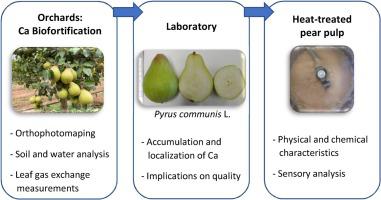当前位置:
X-MOL 学术
›
Sci. Hortic.
›
论文详情
Our official English website, www.x-mol.net, welcomes your
feedback! (Note: you will need to create a separate account there.)
Calcium biofortification of Rocha pears, tissues accumulation and physicochemical implications in fresh and heat-treated fruits
Scientia Horticulturae ( IF 3.9 ) Pub Date : 2021-02-01 , DOI: 10.1016/j.scienta.2020.109834 Cláudia Campos Pessoa , Fernando Cebola Lidon , Ana Rita F. Coelho , João Cravidão Caleiro , Ana Coelho Marques , Inês Carmo Luís , José Carlos Kullberg , Paulo Legoinha , Maria da Graça Brito , José Cochicho Ramalho , Mauro A.M. Guerra , Roberta G. Leitão , Manuela Simões , Paula Scotti Campos , José Manuel N. Semedo , Maria Manuela Silva , Isabel P. Pais , Nuno Leal , Nuno Alvarenga , Elsa M. Gonçalves , Maria José Silva , Ana Paula Rodrigues , Marta Abreu , Maria Fernanda Pessoa , Fernando Henrique Reboredo
Scientia Horticulturae ( IF 3.9 ) Pub Date : 2021-02-01 , DOI: 10.1016/j.scienta.2020.109834 Cláudia Campos Pessoa , Fernando Cebola Lidon , Ana Rita F. Coelho , João Cravidão Caleiro , Ana Coelho Marques , Inês Carmo Luís , José Carlos Kullberg , Paulo Legoinha , Maria da Graça Brito , José Cochicho Ramalho , Mauro A.M. Guerra , Roberta G. Leitão , Manuela Simões , Paula Scotti Campos , José Manuel N. Semedo , Maria Manuela Silva , Isabel P. Pais , Nuno Leal , Nuno Alvarenga , Elsa M. Gonçalves , Maria José Silva , Ana Paula Rodrigues , Marta Abreu , Maria Fernanda Pessoa , Fernando Henrique Reboredo

|
Abstract Low dietary intake of Ca in humans has been epidemiologically linked to various diseases, which can have serious health consequences over time. Accordingly, the development of an agronomic itinerary for Ca biofortification of Rocha pears and the assessment of physicochemical deviations prompted this study. Two orchards with contrasting soil and water characteristics were selected, characterized through orthophotomaping and, during fruits development, leaves were sprayed twice with Ca(NO3)2 (0.1, 0.3 and 0.6 kg ha−1) or CaCl2 (0.4, 0.8 and 1.6 kg ha−1), followed by pulverization only with CaCl2 (first once with 4 kg ha−1 and then four times with 8 kg ha−1). During fruits development net photosynthesis, stomatal conductance, transpiration rates, instantaneous and water use efficiency, only showed minor deviations, which indicated that the threshold of toxicity was not surpassed. Calcium contents varied during fruits development and at harvesting the average biofortification index varied between 47 %–63 % and 24 %–59 % in each of the orchards. Besides, the equatorial region of the fruits showed for all treatments (substantially in Ca treated samples) higher Ca contents in the epidermal and in the central regions. Fresh and heat-treated fruits (in a thermomix at 90 °C, during 10 min) biofortified with Ca only revealed minor differences and the sensory acceptability did not vary markedly. It is concluded that, although prevailing a heterogeneous distribution of Ca in fruit tissues, high indexes of biofortification in Rocha pears can be prompt in the orchards, without substantial physicochemical changes. Accordingly, agronomic biofortification with Ca can be used as a strategy for benefiting consumer’s health.
中文翻译:

Rocha 梨的钙生物强化、组织积累和新鲜和热处理水果的理化意义
摘要 人类饮食中钙摄入量低在流行病学上与各种疾病有关,随着时间的推移,这些疾病可能对健康造成严重后果。因此,罗恰梨 Ca 生物强化农艺路线的制定和理化偏差的评估促使了这项研究。选择了两个具有不同土壤和水特征的果园,通过正射影像进行表征,并且在果实发育过程中,向叶子喷洒两次 Ca(NO3)2(0.1、0.3 和 0.6 kg ha-1)或 CaCl2(0.4、0.8 和 1.6 kg ha-1),然后仅用 CaCl2 粉碎(首先用 4 kg ha-1 粉碎一次,然后用 8 kg ha-1 粉碎四次)。在果实发育过程中,净光合作用、气孔导度、蒸腾速率、瞬时和水分利用效率仅表现出微小的偏差,这表明没有超过毒性阈值。钙含量在果实发育和收获时变化,每个果园的平均生物强化指数在 47%–63% 和 24%–59% 之间变化。此外,果实的赤道区域在所有处理中(基本上在 Ca 处理的样品中)在表皮和中央区域显示出较高的 Ca 含量。用钙生物强化的新鲜和热处理水果(在 90°C 的热混合中,10 分钟内)仅显示出微小的差异,感官可接受性没有显着变化。结论是,尽管钙在果实组织中的分布普遍不均匀,但罗恰梨在果园中的生物强化指数很高,没有实质性的物理化学变化。因此,
更新日期:2021-02-01
中文翻译:

Rocha 梨的钙生物强化、组织积累和新鲜和热处理水果的理化意义
摘要 人类饮食中钙摄入量低在流行病学上与各种疾病有关,随着时间的推移,这些疾病可能对健康造成严重后果。因此,罗恰梨 Ca 生物强化农艺路线的制定和理化偏差的评估促使了这项研究。选择了两个具有不同土壤和水特征的果园,通过正射影像进行表征,并且在果实发育过程中,向叶子喷洒两次 Ca(NO3)2(0.1、0.3 和 0.6 kg ha-1)或 CaCl2(0.4、0.8 和 1.6 kg ha-1),然后仅用 CaCl2 粉碎(首先用 4 kg ha-1 粉碎一次,然后用 8 kg ha-1 粉碎四次)。在果实发育过程中,净光合作用、气孔导度、蒸腾速率、瞬时和水分利用效率仅表现出微小的偏差,这表明没有超过毒性阈值。钙含量在果实发育和收获时变化,每个果园的平均生物强化指数在 47%–63% 和 24%–59% 之间变化。此外,果实的赤道区域在所有处理中(基本上在 Ca 处理的样品中)在表皮和中央区域显示出较高的 Ca 含量。用钙生物强化的新鲜和热处理水果(在 90°C 的热混合中,10 分钟内)仅显示出微小的差异,感官可接受性没有显着变化。结论是,尽管钙在果实组织中的分布普遍不均匀,但罗恰梨在果园中的生物强化指数很高,没有实质性的物理化学变化。因此,











































 京公网安备 11010802027423号
京公网安备 11010802027423号